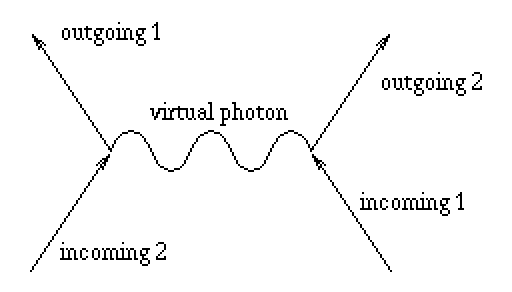
| MadSci Network: Physics |
Dear Tania!
If you had asked this question without any reference to Feynman's book, I would just have advised you to read it --- but now, we're in some sort of trouble ;-). Maybe I can help to clarify some points by giving you a more concise account of Feynman diagrams.
Imagine two charged particles approaching each other. By means of their
charge, they will `feel' each other's presence and repel or attract. Thus
a `scattering process' takes place.
How is this accomplished?
Well, in classical electrodynamics, we could calculate the
outcome of such a process by solving a system of differential equations.
The exact way the particles interact is built into those equations from
the start --- we know that it's a Coulomb potential. Sounds simple,
but the classical way is not the best way. For example, if an electron
and a positron get scattered, there is a probability for them to not
get just scattered but annihilate to give a pair of photons.
This probability cannot be computed classically. So we need a better
theory to explain such processes.
QED is this theory. The basic premise from which we start is that interactions
like the ones described so far can be treated perturbatively, which
means that one treats interactions as a small perturbation to a simpler,
non-interacting `world'. Mathematically, it turns out that one can
calculate scattering probabilities (s.a.) by summing up an infinite
series of small corrections to the non-interacting case --- the case
where the two particles don't scatter at all but just pass each other
without notice. As one adds more terms to the series, one notices that
they get smaller and smaller, so that the series finally converges
to a finite value.
So far so good, but one may ask now what physical significance
those many terms have. And that's where the Feynman diagrams come about:
We can picture each term in the series as a scattering event between
the two incoming particles, but they do not interact via
a Coulomb field --- they exchange virtual particles (photons
in this case).

The simplest such process (the first one in the
series) can be seen in the picture. A point where two electron
(or positron) lines meet a photon line is called a `vertex' (the
black dots in the picture). The
more vertices a diagram contains, the more improbable the described
event gets. This is because every vertex carries a small factor,
and the probability of each event is porportional to the product of
all factors at all vertices in the diagram. In QED, it turns out that
this factor is nothing else but the electric charge.
So, Feynman diagrams are a way to picture terms in a perturbation
series. As suggested by its mathematical structure, each term describes
the exchange of a certain number of virtual particles. Now, to get
the probability for a certain event with a certain accuracy, all one
has to do is draw all allowed diagrams (i.e. allowed by the theory)
with at most a certain number of vertices (i.e. one considers the
perturbation series up to a certain point). Then there is a mathematical
recipe to calculate numbers for each diagram, which in turn give the
desired probability.
All right, I hope this has helped you to understand Feynman's book a little better. This reference might give you some more insight, or at least another point of view. If there's still much confusion left, don't hesitate to contact me by e-mail.
Happy Easter,
Georg.
Try the links in the MadSci Library for more information on Physics.